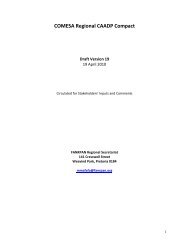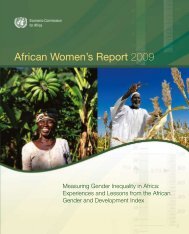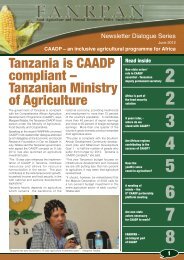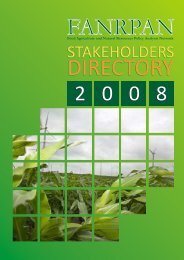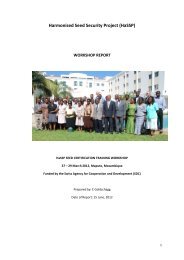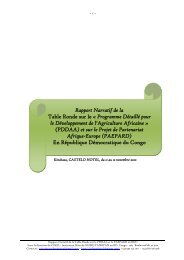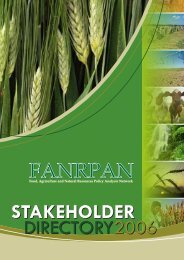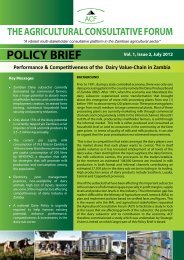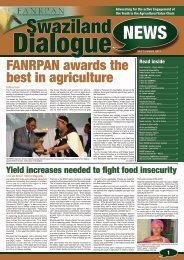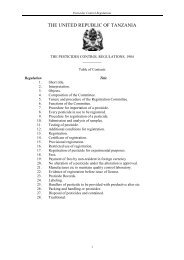Community-driven development decision tools for rural - IFAD
Community-driven development decision tools for rural - IFAD
Community-driven development decision tools for rural - IFAD
- No tags were found...
You also want an ePaper? Increase the reach of your titles
YUMPU automatically turns print PDFs into web optimized ePapers that Google loves.
The way that partnership is negotiated is very important. It establishes the duties and rights of thepartners. The community must feel that it is they who demand the goods or service and not that theproject wants to spend resources at all costs. The community’s fee is a means to acquire the right touse the good or service (i.e. the community is buying the good or service). With this right comes theresponsibility of adequately operating and maintaining the goods and services acquired with theirown hard-earned and saved resources. Project service providers have rights as well (e.g. to inspecthow the community is using the goods or services that the project cofinances).The effectiveness of the arrangement depends on three conditions:• the share of the cost borne by the communities must be at a level that is significantly more thana token amount;• the cost must include a meaningful (even if small) amount of cash;• the cash must be paid in advance. The conditions are strengthened if services are withheld fromthe community until the cash portion of the fee has been paid.These arrangements are transparent, non-discriminatory and leave no room <strong>for</strong> favoring onecommunity over another. They encourage self-selection of project participants and help inequilibrating demand to supply. They also have the advantage of screening out communities thathave become totally state-transfer dependent and <strong>for</strong> that reason offer no credible basis upon whichto launch sustainable <strong>development</strong> activities.Are these arrangements inequitable; that is, can only wealthy communities meet these conditions?If the pre-selection of eligible communities is based on relevant, properly estimated povertyindicators, then the key factor becomes fine-tuning the communities’ expected share, which must notexceed what poor community members can be reasonably expected to af<strong>for</strong>d. It is important <strong>for</strong>adequate methods to be developed and objectively applied to determine what a poor community’sfair contribution should be. Projects should also encourage intra-community solidarity andtraditional reciprocity institutions to devise a progressive way of allocating the community shareamong community members. A system that compensates <strong>for</strong> income disparities among communitymembers and facilitates the participation of the very poor is desirable. It is very important that allmembers carry a burden proportionate to their means, lest those who do not are excluded from thebenefits. This point is well illustrated by the experience of the FODESA project in Mali, which isdescribed in Box 14.Box 14The importance of the communitycontributionA village requested that the <strong>IFAD</strong> FODESAproject in Mali finance the construction of a“boutique villageoise”. When the time came <strong>for</strong>FODESA staff to collect the villagecontribution, the community members felt theywere too poor to mobilize the share of costsrequested by the project. Without in<strong>for</strong>mingFODESA, the people of the village struck adeal with a wealthy resident merchant, whooffered to pay the entire communitycontribution himself. When the boutique wasconstructed, the merchant seized theexclusive right to manage the infrastructure onthe strength of his financial contribution andappointed all the members of the managementcommittee. After a while, the business wasmismanaged, with sales revenuemisappropriated to the advantage of themerchant, who considered himself the onlyshareholder of the enterprise.The village complained to FODESA, requestingan intervention to help put the business backon a sustainable basis <strong>for</strong> the benefit of all themembers of the community. The instrument toimplement this policy was the collection of thevillage’s share of costs, which was paid to themerchant to reimburse his initial contributionon condition that he withdraw his participationin the management of the boutique. This timethe community members met with no difficultyin mobilizing their contribution and were free toelect their own trusted members of themanagement committee.Source: Kady Diallo. Communication to <strong>IFAD</strong> 2005 e-conferenceon CDD.26



